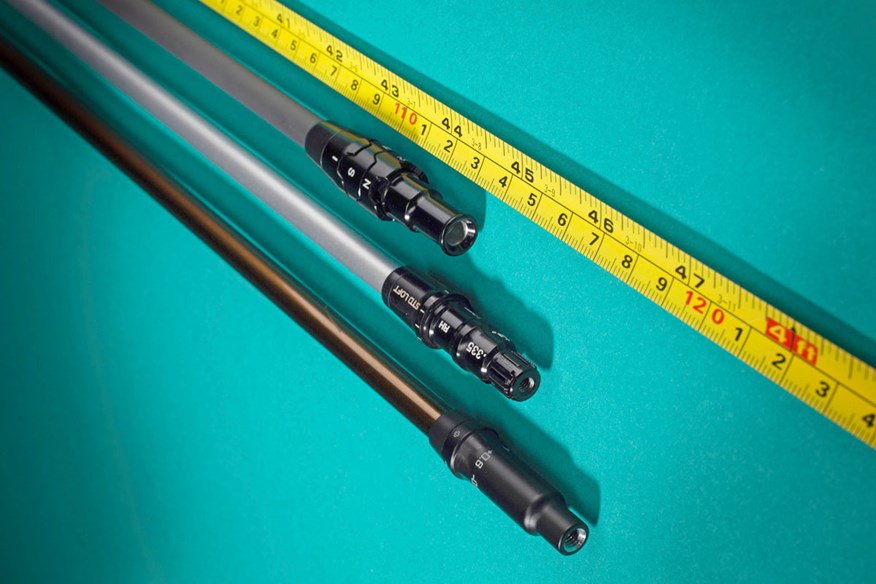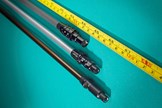“90% of driver shafts are too long”
Last updated:
Is your golf driver shaft too long for you?
What length is your driver shaft? For most golfers, the answer is “no idea”, “a bit longer than my 3-wood” or “not quite long enough to get me out of that bush when I’m using it to measure where I’m allowed to drop”. And why would you know or care? They’re all pretty much the same, right?
RELATED: Best Golf Drivers
But what if we told you that the driver in your bag now is probably two, three or even four inches longer than the one you had 15 years ago?
And what if we told you that extra length could be making it harder for you to hit the ball solidly, causing you to miss more fairways, and possibly even costing you distance off the tee?
And, finally, have you ever wondered why the best players on the planet are using shafts that are shorter than the ones being used by most amateurs?
Related: Most Forgiving Drivers
“I’d say 90 per cent of the drivers sold in the shops today are too long for most players,” says esteemed clubmaker Tom Wishon, of Wishon Golf. “The standard driver length of 45.5-46.5 inches offered by the majority of companies is too long for most golfers and will prevent them from achieving their maximum potential for distance and accuracy.”

Growing pains
Most driver shafts were around 43 inches until the early 1990s. The stock standard now is anywhere from 45.5 to 46.75 inches. There are two reasons for that growth. First, driver head size has increased significantly. Put a bigger head on the same length shaft you’re used to and it looks huge because your eye isn’t used to it, so shafts have increased to look more aesthetically pleasing.
And second – the biggest factor – the way we buy drivers has changed.
Related: Robot test – Which golf ball best suits your game?
Twenty years ago, you tried a few and bought the one you liked the best or the one that seemed to put you in the best positions. Nowadays, with the advent and proliferation of launch monitors, you can see exactly how far you’re hitting any driver you’re contemplating buying.
You can get instant feedback on launch angle, carry distance, total spin, sideways curvature and umpteen other metrics.
But there’s only one that the majority of golfers want to know: “How far did that go?”
Golfers are more obsessed than ever with hitting the ball as far as they can off the tee. And when a new driver can cost upwards of £450, you want as much yardage as possible for your money.
Related: Longest Driver 2020
Go and hit 50 balls using several different drivers with different shaft options and you’ll have a soft spot for the one that hit the longest drive of the day.
Manufacturers know a longer shaft gives them the best chance of achieving the “wow, that’s gone a mile” shot that stays in your mind and tempts you to part with your cash. That’s why shaft lengths keep getting longer – and we can’t blame manufacturers if that’s what we buy.

Driver distance sells golf clubs
“Longer driver shafts can create more clubhead speed, resulting in additional ball speed and overall distance gains,” says Custom Lab Golf founder Gavin Hay. “That’s why manufacturers have continually increased their standard spec driver shaft lengths over the years. They want their drivers to outperform other brands on raw distance.”
If longer shafts mean longer drives, isn’t this good news for us? Probably not, says Hay. “If a driver shaft is too long for the player, they can struggle to find the middle consistently. Off-centre hits not only drastically reduce ball speed and distance, but have a big impact on accuracy.”
Related: Best Drivers for Beginners and High Handicappers
So why do manufacturers sell shafts that are holding us back?
“The golf industry will generally go with whatever has worked well in testing,” says clubfitter and club builder Derek Murray of ForeGolf. “Under robot testing, you may find that if you take a longer shaft and hit it out of the screws, it could go five or eight yards further. So hit one right out of the middle with a long shaft and it will go far. But hit one out of the toe and you’ll lose eight or nine miles per hour in ball speed, which will end up costing you distance.”
Is it possible, then, that a shorter shaft may actually help you hit the ball further?
“We’ve seen a good number of players lose zero clubhead speed when testing a shaft that is an inch shorter than their current driver shaft, and they have found the centre of the clubface more consistently,” says Hay. “This improvement in strike generates higher ball speed, which is what creates distance.”
Related: Callaway’s 2021 Epic woods revealed and tested
If you’re not as good with a driver in your hands as the best players on the planet, why would you expect to be able to hit a driver with a longer shaft than they can?
“I very rarely build drivers that are 46 inches long,” says Murray, a former tour fitter who finds the vast majority of his clients are better off with a shaft that’s shorter than the manufacturer standard. “On tour I very rarely built drivers that were over 45 inches long.”
And Wishon agrees. “There’s a very good reason the average driver length on the PGA Tour is 44.5 inches and not 45.5 or 46.5.”

Putting it to the test
We built a Callaway Rogue driver in 43.5, 44.5 and 45.5 inches, with everything but the shaft length identical. The longer shaft did produce the highest average clubhead speed at 97.9mph, which also generated the highest ball speed at 146.1mph. But the resulting total distance of 273.7 yards was outdone by the 44.5-inch driver, which generated an average of 274.4 yards, despite clubhead speed being 1.3mph slower. The carry distance was four yards longer with the 44.5-inch shaft than its longer brother.
The reason? Strike. Our tester was able to find the middle of the clubface better with an inch taken off the shaft. The shortest shaft did produce the shortest drives, but only by three yards.
Dispersion was best with the shortest shaft and worst with the longest.
Related: Best Drivers 2020
The long and the short of it
It’s not a simple case of shorten your shaft and your handicap will fall. Your current length may be perfect for you. You may even need a longer one. But, as our experts and test have shown, a good number of golfers would benefit from a shorter shaft.
You may actually increase distance and there’s a good chance you’ll hit more fairways.
“Try shorter,” suggests Murray, who says that even half an inch can make a big difference – “45.5 is better than 46 in my experience, for the majority of golfers.”
How to find the right driver shaft length for YOU
1. There is no standard length
“There’s no golden length that is right for everyone, it’s totally individual,” says Derek Murray. “A lot will depend on timing, hand-eye co-ordination, individual ability and how you like a driver to feel. It’s not about your handicap, your swing speed or your height. The bottom line is that no one will know how a human golfer will react to something until they physically hit it.”
2. Test them out
“If you want to find out whether your driver is the optimum length to suit your swing, we highly recommend visiting an independent club fitter who uses a premium launch monitor, such as Trackman, GC2 or Flightscope,” says Gavin Hay. “Find someone who carries a wide selection of shafts at different lengths.”
3. Consider the whole package
If you’ve realised your driver shaft is too long for you, it’s not as simple as just chopping a few inches off your existing shaft.
“Be careful when changing shaft length as the swing weight will be affected which will result in a totally different feel,” says Hay. “If the shaft is shortened by an inch, you would need additional weight in the head to get the same swing weight. A good fitter can manage these variables for you to create a shaft that feels and performs the way you want.”
READ NEXT: How to choose the right fairway wood for your game




